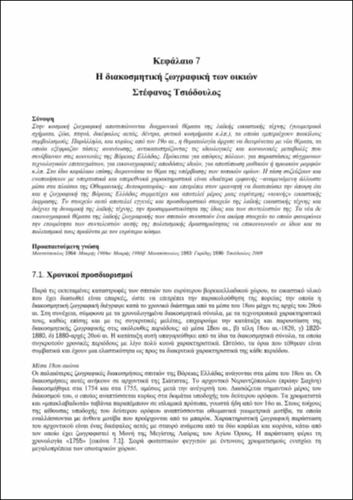| Title Details: | |
|
The decorative painting of the houses |
|
| Authors: |
Tsiodoulos, Stefanos |
| Reviewer: |
Sampanikou, Evangelia |
| Description: | |
| Abstract: |
Over time, themes of folk art have continuously been evidenced in laypeople’s visual drawings. Some examples include geometric shapes, animals, birds, the two-headed eagle, trees and floral ornaments, to name a few. These, of course, express a wealth of symbolisms. From the 19th century onwards, newer themes would make their way into the existing thematology, thus paving the way for new trends that would reflect the ideological and social changes occurring in the communities of Northern Greece at the time. These new trends would reflect urban views and the emergence of modern technological developments. Illustrations would depict the ideas of the time and prints of mythical or heroic figures would become a common occurrence. In this same chapter the urge to exceed local limits is also explored. A trend that is particularly evident is the tendency to unite and integrate supralocal and supranational features – as would be expected in the Ottoman Empire. This allows the researcher to reach the conclusion that drawings from Northern Greece must be part of a larger “folk-like” artistic expression. This expression is composed of a visual art that is intrinsic and identity-defining and thus shows the dynamics of a folkloric culture, its adaptability and that of its artists. These new illustrative themes depicted on folk drawings, such as those found in local homes, constitute another element that demonstrates the artists’ readiness to communicate their cultural products to the wider world.
|
| Linguistic Editors: |
Karampalis, Spyridon |
| Technical Editors: |
Zinas, Nikolaos |
| Graphic Editors: |
Koumartzis, Nikolaos |
| Type: |
Chapter |
| Creation Date: | 2015 |
| Item Details: | |
| License: |
Attribution - NonCommercial - ShareAlike 4.0 International (CC BY-NC-SA 4.0) |
| Spatial Coverage: |
Βόρεια Ελλάδα |
| Temporal Coverage: |
19ος αιώνας |
| Handle | http://hdl.handle.net/11419/3931 |
| Bibliographic Reference: | Tsiodoulos, S. (2015). The decorative painting of the houses [Chapter]. In Zarra, I., Merantzas, C., & Tsiodoulos, S. 2015. From Post-Byzantine to Modern Civilization [Undergraduate textbook]. Kallipos, Open Academic Editions. https://hdl.handle.net/11419/3931 |
| Language: |
Greek |
| Is Part of: |
From Post-Byzantine to Modern Civilization |
| Number of pages |
39 |
| Publication Origin: |
Kallipos, Open Academic Editions |

